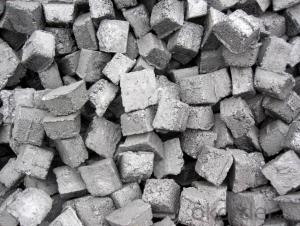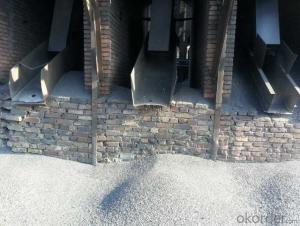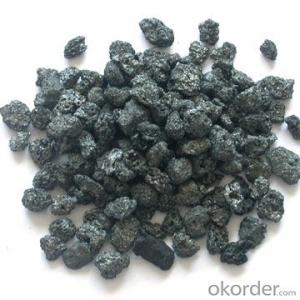Calcined Anthracite CNBM High Quality Anthracite
- Loading Port:
- Tianjin
- Payment Terms:
- TT OR LC
- Min Order Qty:
- 0 m.t.
- Supply Capability:
- 100000 m.t./month
OKorder Service Pledge
OKorder Financial Service
You Might Also Like
Packaging & Delivery
| Packaging Detail: | 25kgs/50kgs/1ton per bag or as buyer's request |
| Delivery Detail: | Within 20 days |
Advantage and competitive of caclined anthracite
1. strong supply capability
2. fast transportation
3. lower and reasonable price for your reference
4.low sulphur, low ash
5.fixed carbon:95% -90%
6..sulphur:lower than 0.3%
Specifications
Calcined Anthracite
Fixed carbon: 90%-95%
S: 0.5% max
Size: 0-3. 3-5.3-15 or as request
Calcined Anthracite is produced using the best Anthracite-Taixi Anthracite with low S and P, It is widely used in steel making and casting.
General Specification of Calcined Anthracite:
PARAMETER UNIT GUARANTEE VALUE | |||||
F.C.% | 95MIN | 94MIN | 93MIN | 92MIN | 90MIN |
ASH % | 4MAX | 5MAX | 6MAX | 7MAX | 8MAX |
V.M.% | 1 MAX | 1MAX | 1.5MAX | 1.5MAX | 1.5MAX |
SULFUR % | 0.5MAX | 0.5MAX | 0.5MAX | 0.5MAX | 0.5MAX |
MOISTURE % | 0.5MAX | 0.5MAX | 0.5MAX | 0.5MAX | 0.5MAX |
Size can be adjusted based on buyer's request.
Pictures of Calcined Anthracite:

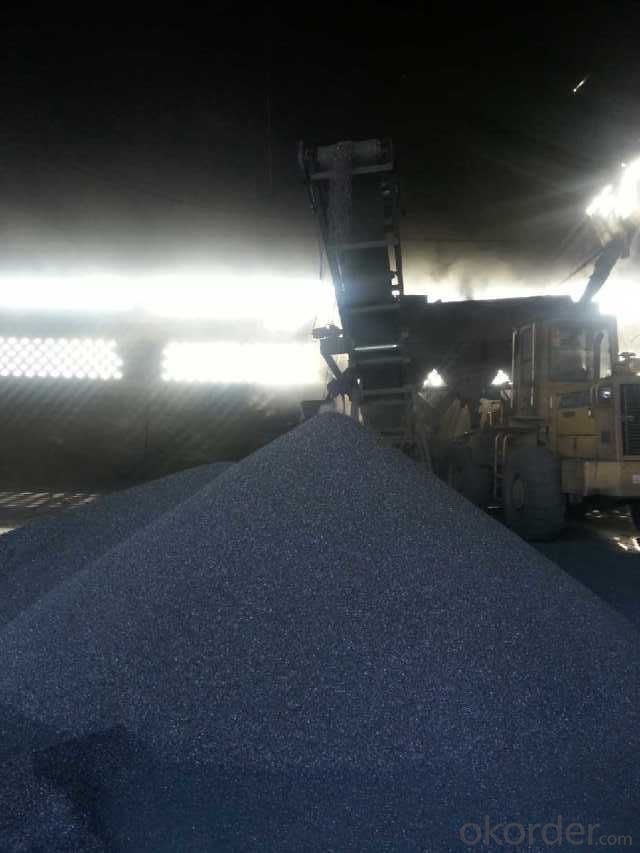
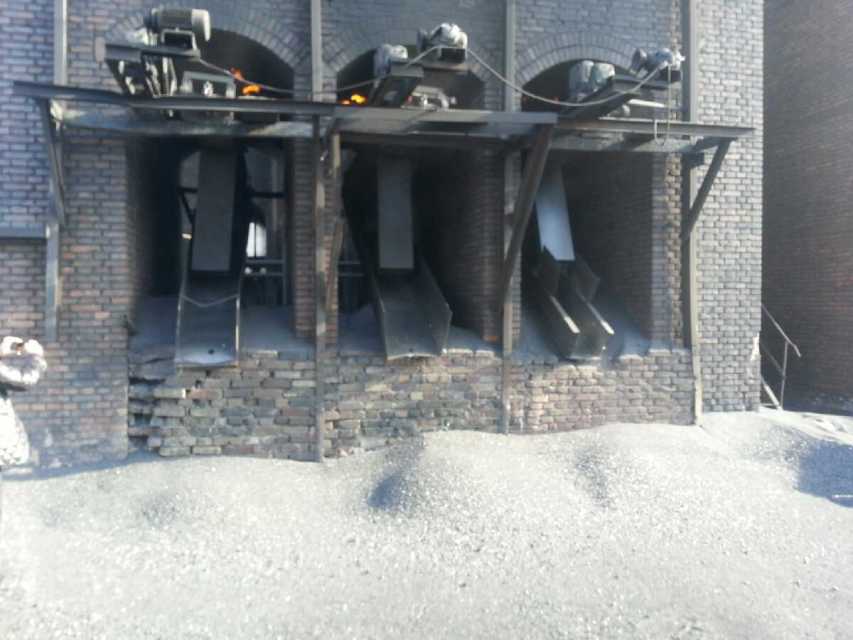

We can supply below furnace charges, please feel free to contact us if you areinterested in any of any of them:
Coke (Metallurgical, foundry, gas)
Calcined Anthracite with fixed carbon from 90% to 95%
Calcined Petroleum Coke
Graphite petroleum coke
Amorphous Graphite
- Q:What are the properties of carbon fibers?
- Carbon fibers are known for their exceptional strength and stiffness, making them ideal for applications requiring high-performance materials. They possess a low density, corrosion resistance, and excellent thermal conductivity. Additionally, carbon fibers exhibit high resistance to fatigue and have a high tensile strength, allowing them to withstand extreme conditions. They are also chemically inert and have a low coefficient of thermal expansion, making them versatile for various industries such as aerospace, automotive, and sports equipment.
- Q:What are fossil fuels and how are they formed?
- Fossil fuels, derived from ancient plants and animals, are natural resources utilized by humans for centuries as non-renewable sources of energy. Coal, oil, and natural gas comprise the three primary types of these fuels. The genesis of fossil fuels commences with organic matter sourced from plants and animals. Over millions of years, this organic material becomes deeply buried within the Earth's crust. Through the accumulation of sediment layers, the organic matter experiences increased pressure and heat, resulting in the process of fossilization. Regarding coal, the organic matter primarily consists of compacted and heated plant material. As the pressure and temperature rise, the plant material undergoes a gradual chemical transformation, eventually becoming coal. The formation of oil and natural gas follows a slightly different path. It originates from the remains of minuscule marine microorganisms, such as plankton, which settle at the ocean floor. Over time, these organic materials become buried beneath sediment layers, where they endure immense heat and pressure. Under these conditions, the organic matter undergoes a conversion into a mixture of hydrocarbons, serving as the primary constituent of oil and natural gas. Subsequently, the oil and gas migrate through porous rocks until they become trapped by impermeable layers, giving rise to oil or gas reservoirs. Overall, the formation of fossil fuels constitutes a gradual geologic process taking millions of years. It necessitates specific conditions of heat, pressure, and burial to convert organic matter into coal, oil, or natural gas. Due to their limited availability and the environmental consequences associated with their combustion, there is an increasing emphasis on transitioning towards renewable energy sources as a more sustainable alternative.
- Q:What type of carbon copy sheet can be printed on? How many copies?
- Printed in carbon free carbon paper, usuallyUpper: whiteMedium: RedNext: yellowMainly depends on how much you want to print.
- Q:What are the effects of carbon emissions on the stability of estuaries?
- Carbon emissions have significant effects on the stability of estuaries. Estuaries are highly productive and diverse ecosystems that serve as a crucial habitat for numerous species, including fish, birds, and other wildlife. However, excessive carbon emissions, primarily in the form of carbon dioxide (CO2), contribute to climate change and ocean acidification, which in turn have detrimental effects on estuaries. One of the most prominent effects of carbon emissions on estuaries is the rise in sea levels. As global temperatures increase due to carbon emissions, glaciers and ice caps melt, leading to a rise in sea levels. Estuaries, being low-lying areas where rivers meet the sea, are particularly vulnerable to this sea-level rise. Higher water levels can result in increased flooding, erosion, and saltwater intrusion into freshwater systems within estuaries, impacting the overall stability of these ecosystems. Moreover, the increased concentration of CO2 in the atmosphere leads to ocean acidification. When CO2 dissolves in seawater, it reacts with water to form carbonic acid, which lowers the pH of the water. This acidification has detrimental effects on the marine life within estuaries, including shellfish, oysters, and other organisms with calcium carbonate shells. The acidity makes it more difficult for these organisms to build and maintain their shells, leading to reduced populations and biodiversity within estuaries. Additionally, climate change caused by carbon emissions alters the temperature and precipitation patterns in estuaries, affecting the balance of salinity and freshwater influx. Estuaries rely on a delicate balance of saltwater and freshwater to support their unique ecosystems. Changes in temperature and precipitation can disrupt this balance, leading to significant shifts in species composition and distribution. Some species may struggle to adapt to these changes, while invasive species may thrive, further altering the stability and integrity of estuarine ecosystems. Overall, the effects of carbon emissions on the stability of estuaries are profound and multifaceted. Rising sea levels, ocean acidification, and climate-induced changes in salinity and freshwater availability all contribute to the degradation of estuaries and the loss of biodiversity. It is crucial to reduce carbon emissions and mitigate climate change to protect and preserve these vital ecosystems for future generations.
- Q:What is the composition of carbon in stainless steel?
- Adjust the hardness, general carbon content, the higher the relative hardness is relatively hard. But no, the higher the better, the carbon content needs to be well controlled. For example, if the welding position is too high carbon, it will lead to brittle weld and easy to crack.
- Q:How does carbon affect the formation of smog?
- Carbon plays a significant role in the formation of smog, particularly in the form of carbon monoxide (CO) and volatile organic compounds (VOCs). When fossil fuels are burned, such as in vehicles, power plants, or industrial processes, carbon is released into the atmosphere in the form of CO and VOCs. These carbon emissions, especially in areas with high population density, can contribute to the formation of smog. Smog is a mixture of air pollutants, primarily ground-level ozone, which is formed when nitrogen oxides (NOx) and VOCs react in the presence of sunlight. Carbon monoxide is a precursor to the formation of ground-level ozone. It reacts with nitrogen oxides and sunlight to form ozone, a major component of smog. VOCs, on the other hand, react with nitrogen oxides in the presence of sunlight to form additional ground-level ozone. Additionally, carbon particles, also known as black carbon or soot, can contribute to the formation of smog. These particles absorb sunlight and heat the surrounding air, leading to temperature inversions. Temperature inversions trap pollutants close to the ground, preventing them from dispersing and exacerbating smog formation. Reducing carbon emissions is crucial in controlling and preventing smog formation. Implementing cleaner technologies, such as catalytic converters in vehicles and using cleaner fuels, can help decrease the release of carbon monoxide and VOCs. Furthermore, promoting renewable energy sources and reducing reliance on fossil fuels can significantly reduce carbon emissions, thus mitigating the formation of smog.
- Q:How is carbon used in the production of paints?
- Carbon is used in the production of paints as a pigment or coloring agent. Carbon black, which is made from the incomplete combustion of petroleum products, is commonly used to provide a deep black color to paints. It is also used in the form of graphite to create black or gray shades. Additionally, carbon-based materials like activated charcoal are used as fillers or extenders in certain types of paints.
- Q:What is the carbon content of different types of household waste?
- The carbon content of different types of household waste can vary significantly. Generally, organic waste such as food scraps, yard trimmings, and paper products have high carbon content, while non-organic waste like plastics and metals have low or no carbon content.
- Q:How does carbon affect the formation of acidification in lakes?
- Carbon dioxide (CO2) plays a significant role in the formation of acidification in lakes. When carbon dioxide is released into the atmosphere through various human activities, such as burning fossil fuels, it can be absorbed by water bodies like lakes. This absorption leads to the formation of carbonic acid (H2CO3), a weak acid. Carbonic acid dissociates into hydrogen ions (H+) and bicarbonate ions (HCO3-) in water. The increase in hydrogen ions causes a decrease in pH levels, making the water more acidic. This process is known as acidification. Acidification in lakes can have detrimental effects on aquatic ecosystems. It affects the physiology and behavior of many species, including fish, amphibians, and invertebrates. Acidic waters can also damage the eggs and larvae of these organisms, hindering their growth and survival. Additionally, acidification can alter the composition and abundance of phytoplankton, which are crucial for the overall health of the ecosystem. High levels of acidity can also lead to the leaching of toxic metals, such as aluminum, from the surrounding soil and rocks. These toxic metals are then dissolved in the water, posing an additional threat to aquatic organisms. Acidification can also disrupt the nutrient cycles in lakes, affecting the availability of essential nutrients for plants and animals. In summary, the presence of carbon dioxide in the atmosphere contributes to the acidification of lakes when it is absorbed by water. This acidification has a range of negative impacts on the aquatic ecosystem, including altered physiology, impaired reproduction, and disrupted nutrient cycles. It is crucial to reduce carbon emissions and mitigate the effects of acidification to protect the health and diversity of lake ecosystems.
- Q:How is carbon used in the production of graphite?
- The production of graphite relies heavily on carbon, which undergoes extreme heat and pressure to form its distinctive crystalline structure. The process commences with a high-quality carbon source, like petroleum coke or coal tar pitch, which is heated to eliminate impurities and transform it into pure coke. This coke is then ground into a fine powder and combined with a binder, typically pitch, to create a paste. The paste is molded into the desired shape, such as rods or blocks, and exposed to high temperatures in a furnace. The heat prompts the decomposition of the binder and the rearrangement of carbon atoms into hexagonal layers, characteristic of graphite. The furnace's high pressure aids in aligning the carbon layers, resulting in the formation of graphite crystals. Following the furnace process, the graphite undergoes further purification through treatments like chemical washing and acid leaching to eliminate any remaining impurities. Ultimately, the purified graphite is shaped into the final product, such as pencils, electrodes, or lubricants, using techniques like extrusion or machining. To summarize, the production of graphite involves subjecting a carbon source to high temperatures and pressures, leading to the creation of graphite crystals with its unique layered structure. This process enables the manufacturing of diverse graphite products, widely utilized in industries such as manufacturing, electronics, and energy.
1. Manufacturer Overview |
|
|---|---|
| Location | |
| Year Established | |
| Annual Output Value | |
| Main Markets | |
| Company Certifications | |
2. Manufacturer Certificates |
|
|---|---|
| a) Certification Name | |
| Range | |
| Reference | |
| Validity Period | |
3. Manufacturer Capability |
|
|---|---|
| a)Trade Capacity | |
| Nearest Port | |
| Export Percentage | |
| No.of Employees in Trade Department | |
| Language Spoken: | |
| b)Factory Information | |
| Factory Size: | |
| No. of Production Lines | |
| Contract Manufacturing | |
| Product Price Range | |
Send your message to us
Calcined Anthracite CNBM High Quality Anthracite
- Loading Port:
- Tianjin
- Payment Terms:
- TT OR LC
- Min Order Qty:
- 0 m.t.
- Supply Capability:
- 100000 m.t./month
OKorder Service Pledge
OKorder Financial Service
Similar products
New products
Hot products
Hot Searches







